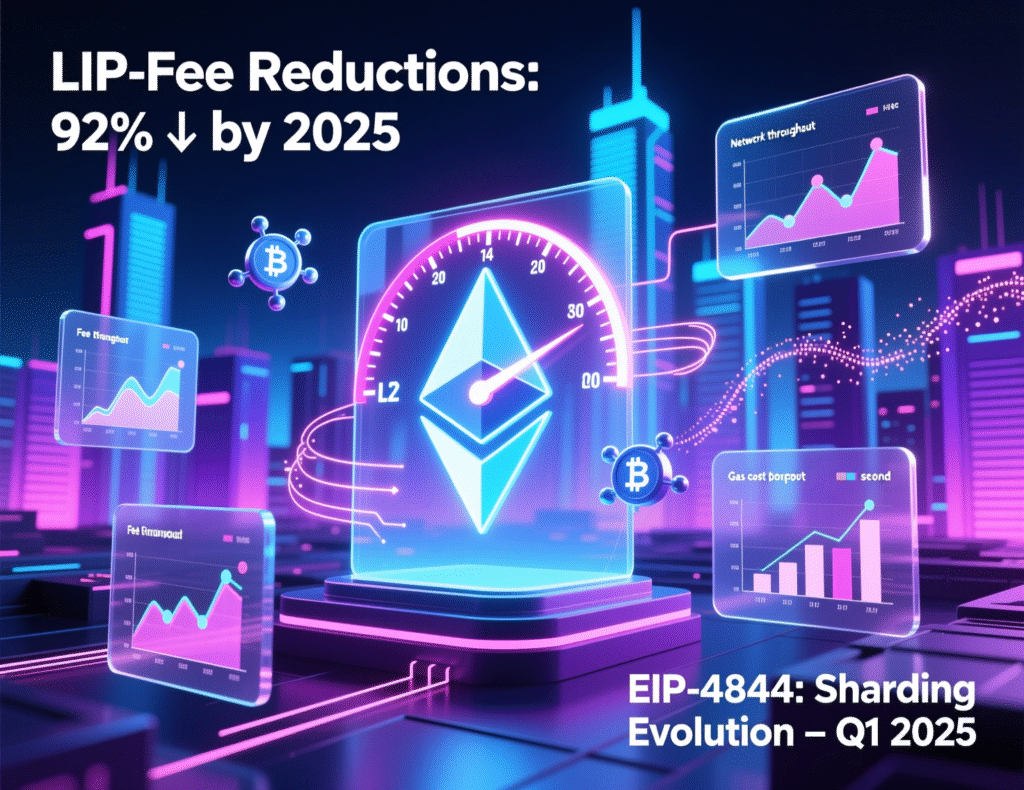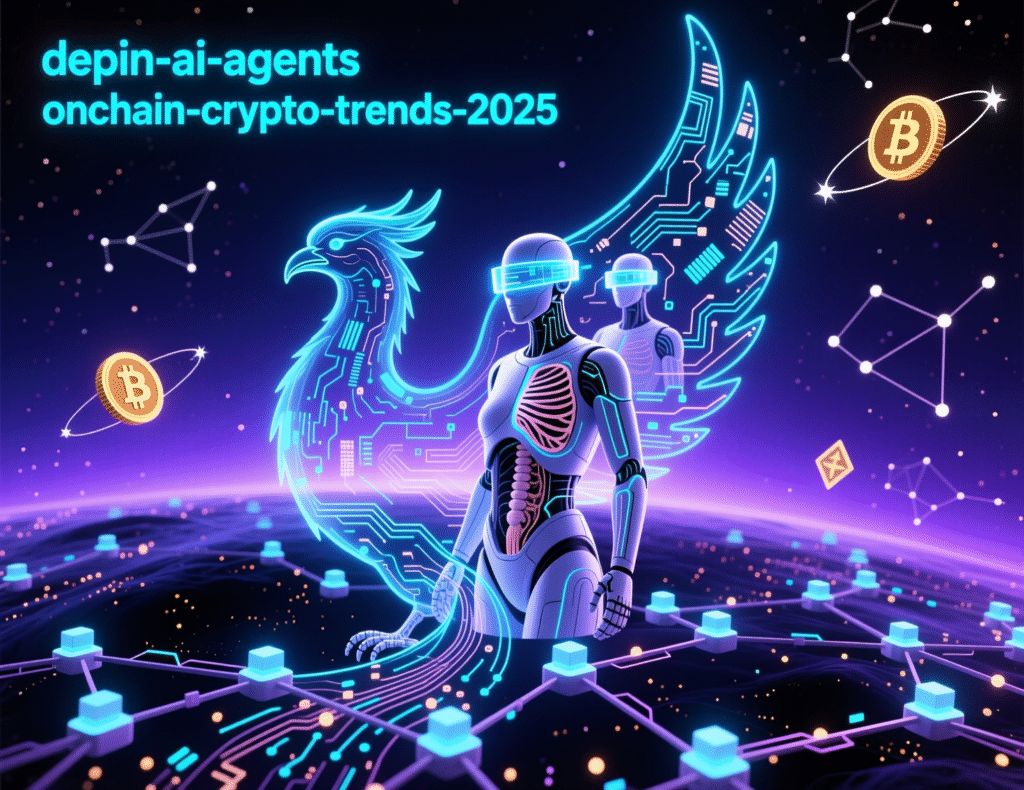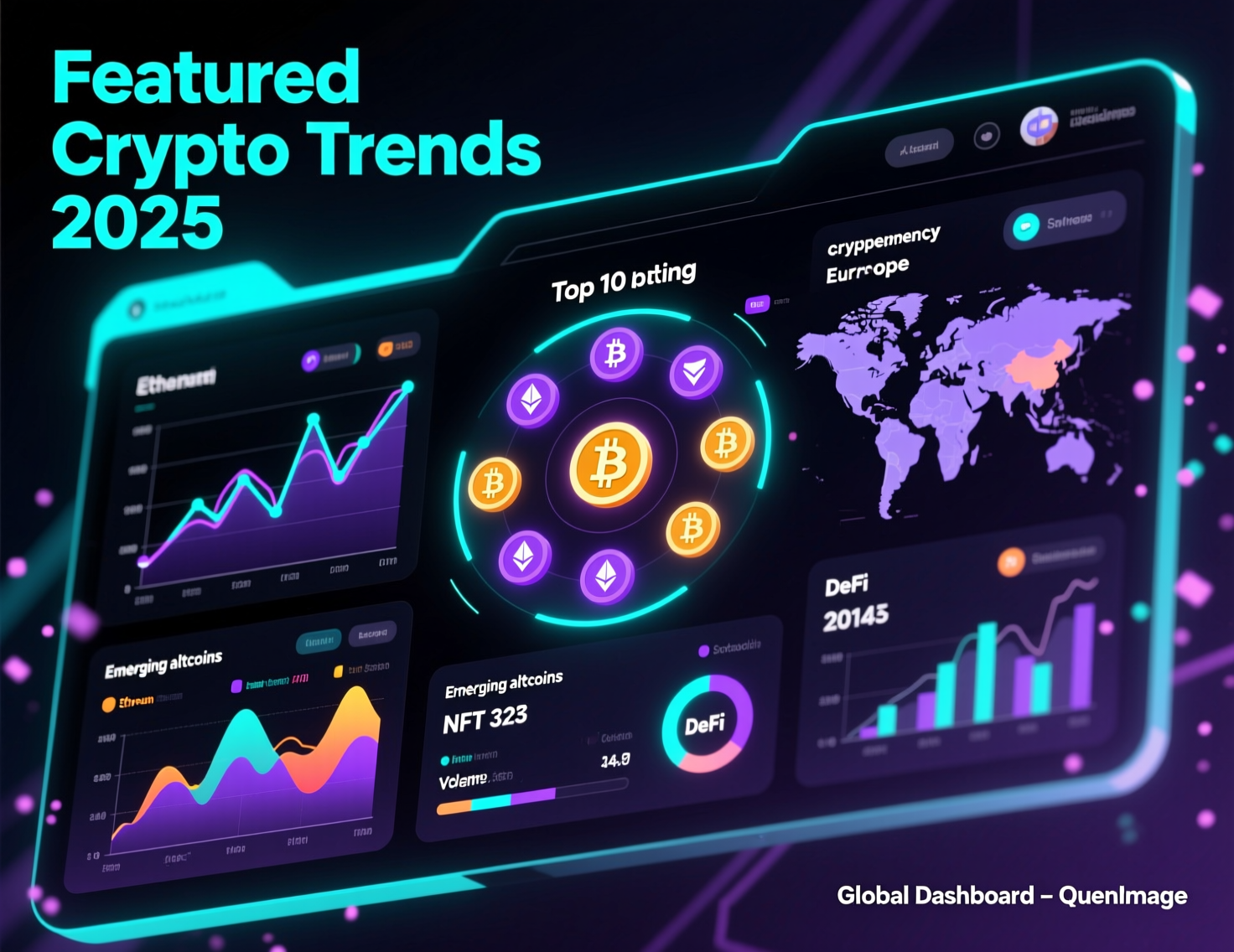Top Crypto Trends Defining 2025
If 2024 was the setup, 2025 is the year crypto goes mainstream. Institutional-grade products, regulatory clarity in key regions, and real-world utility have propelled adoption beyond speculative phases. Spot Bitcoin ETFs have funneled tens of billions into the asset class, while stablecoins topped $300B in market cap for the first time, cementing their role as crypto’s settlement layer. Meanwhile, real-world asset (RWA) tokenization crossed the $30B milestone, with tokenized Treasuries alone in the mid-single-digit billions. MarketWatch+3farside.co.uk+3The Block+3
In this guide to crypto trends 2025, we’ll decode the forces shaping this cycle: ETF-driven flows, stablecoin payment rails, RWAs, L2 scalability after EIP-4844, restaking and shared security, DePIN, and the fast-emerging AI x Crypto stack. We ground every section in recent data and trusted sources, add practical implications for builders and investors, and close with a concise action plan.
Whether you run a fintech product, allocate capital, or simply want to understand where Web3 is heading, this deep dive into crypto trends 2025 equips you to make better decisions today.
ETFs Turn Crypto Into an Allocatable Asset Class
Spot Bitcoin ETFs have converted latent demand into measurable flows. U.S. products alone have amassed $60B+ net inflows since launch, with daily flow trackers now a staple of market analysis. Global ETF flows hit record weekly highs in October 2025 as bitcoin set new ATHs.
Why it matters for crypto trends 2025
Portfolio construction
ETFs lower operational friction for RIAs, pensions, and family offices paving the way for model-portfolio allocations.
Liquidity flywheel
More inflows → deeper markets → lower spreads → more inflows.
Knock-on effects
Ethereum and multi-asset ETFs are expanding outside the U.S., reinforcing the institutional bridge.
Builder/brand takeaway
Position products for ETF-adjacent demand (analytics, tax, custody overlays, staking yield wrappers where compliant).
Stablecoins Become the Internet’s Settlement Layer
The stablecoin market cap broke $300B in 2025, an all-time high, with USDT dominant and USDC strengthening through enterprise rails and a major IPO. The IMF’s Crypto Monitor corroborates the sector’s expansion. In the EU, MiCA phases took effect for stablecoins in mid-2024 and for CASPs by December 2024, shaping 2025 operations.

Why it matters for crypto trends 2025
Payments & remittances
Instant, 24/7 settlement with transparent reserves.
Treasury use cases
On-chain cash management and programmable payouts.
Regulatory clarity
MiCA’s timeline reduces uncertainty for EU operators.
Stat to watch
Stablecoin dominance as a % of total crypto market cap an indicator of utility vs. speculation.
RWAs Cross $30B Tokenized Treasuries Lead
Tokenization of real-world assets surged past $30B, with Treasuries in the $5–7B band by mid-2025 and major asset managers entering the stack. World Economic Forum and market coverage highlight accelerating institutional pilots, while a16z’s 2025 report frames RWAs as a core adoption vector.
Why it matters for crypto trends 2025
Yield on-chain
T-bill yields, money-market funds, and private credit instruments now plug directly into DeFi collaterals.
Operational efficiency
24/7 settlement, programmable compliance, real-time NAV.
Institutional signals
BNY Mellon, Goldman Sachs, BlackRock and others have stepped in across tokenized money markets and funds.
Case study (brief)
BlackRock/Securitize BUIDL
Share of tokenized Treasuries reached ~45% by April 2025, helping the category lift to ~$5.5B.
Post-4844, L2s Are the New Default
After Ethereum’s EIP-4844 upgrade (proto-danksharding) in 2024, L2 transaction costs fell 10–90% and daily activity climbed, with many L2s now pricing mainstream transactions at < $0.01. L2Beat tracks activity expansion across rollups; independent analyses show dramatic fee compression on Arbitrum and peers.

Why it matters for crypto trends 2025
Unit economics
Cheaper blockspace → viable consumer apps (social, gaming, micropayments).
Modular stacks & RaaS
OP Stack, Arbitrum Orbit, ZK frameworks fuel “rollups-as-a-service” for brands and games.
Builder tip
Design for L2 first. Use account abstraction and paymasters to hide gas from end users.
Restaking & Shared Security Go Prime Time
EigenLayer spearheaded restaking’s growth with TVL expanding into the tens of billions through 2024–2025, creating a marketplace for Ethereum-based trust and Actively Validated Services (AVSs). This shared security design underpins oracles, data availability, and specialized services.
Why it matters for crypto trends 2025
Capital efficiency
Reuse staked ETH to secure additional protocols.
New risk surface
Slashing vectors, correlation risk, and operator set centralization require robust risk frameworks.
Ecosystem effect
Restaking expands the design space for DeFi/security middleware.

DePIN Turns On-Chain Work Into Real-World Networks
Decentralized Physical Infrastructure (DePIN) wireless (Helium), mapping (Hivemapper), compute (io.net), mobility sensors (NATIX)—posted multi-million-dollar monthly on-chain revenues in 2025, with some analyses projecting $100M+ annualized across leading projects. Solana’s DePIN cohort has reported record months, underscoring product-market fit.
Why it matters for crypto trends 2025
Real-world utility
Contributors earn tokens for delivering bandwidth, maps, compute.
Enterprise integrations
DePIN data markets become inputs for AI, logistics, and city ops.
Moats
Bootstrapped by incentives; sustained by real demand.
AI x Crypto Agents That Hold Keys, Pay, and Build
2025 saw AI agents begin to operate on-chain: reading balances, signing with smart wallets, and paying via stablecoins. a16z’s report and recent market coverage highlight agent payment rails (e.g., x402/MCP) and wallet connectivity to major models, including Coinbase Wallet’s integrations.
Why it matters for crypto trends 2025
Autonomous commerce
Agents subscribe to APIs, buy compute/storage, tip creators.
Proof + provenance
On-chain records ensure verifiable data/asset ownership for AI pipelines.
Design pattern
Intent-based UX and “solvers” compete to fulfill user goals at best price/latency.
Regulation From Europe’s MiCA to Global Clarity
The EU’s MiCA now governs stablecoins (since June 30, 2024) and brings CASP authorization into full effect (Dec 30, 2024), shaping crypto trends 2025 across issuance, disclosures, and passporting. PwC’s 2025 report surveys global regimes converging on clearer frameworks. CBDCs remain a parallel track: the Atlantic Council tracker and other sources show expanding pilots, including India’s e-rupee growth into 2025.
Why it matters: Compliance-by-design becomes a product feature; programmable compliance and zk-KYC gain traction.
CBDCs Experimentation Continues, With Regional Leaders
Research and pilots continue across 100+ jurisdictions, with many central banks exploring both retail and wholesale models. India’s e-rupee pilot expanded features and balances through 2025; BIS research and industry trackers document the pace.
Implication for crypto trends 2025: Expect more bridges between CBDC rails and regulated stablecoins for cross-border B2B flows.
Security, MEV, and Intent-Centric UX
As activity concentrates on L2s and app-chains, MEV minimization and intent-based transaction routing shape UX. Account abstraction (ERC-4337) makes gasless and session-key experiences standard, while formal verification and runtime monitors become table-stakes for serious teams.
Two Mini Case Studies
Case 1 Tokenized Treasuries for Treasury Ops (Fintech)
A global SaaS company uses tokenized T-bills to park idle cash over weekends, cutting settlement time from T+1 to near-instant and earning on-chain yield. After policy checks, the firm whitelists an issuer and automates redemptions to USDC for payroll on Mondays. Result: better cash efficiency with auditable on-chain records.
Case 2 Consumer App Switching to L2 (Gaming)
A studio migrated in-game assets and micro-purchases to an L2 with < $0.01 fees. Session keys abstract wallets; fiat on-ramps fund stablecoin balances; NFT drops become low-friction. Retention rises as purchases feel “instant,” and the studio experiments with AI agents that trade skins permissible by region.
How to Act on These Crypto Trends 2025 (Checklist)
Add stablecoin rails; map MiCA/region-specific compliance now.
Pilot RWA integrations for treasury and collateral.
Ship on L2; adopt account abstraction and paymasters.
Evaluate restaking exposure (upside vs. correlated risk).
Test AI-agent automations for support, payments, and ops.
Track ETF and stablecoin metrics weekly for signals.

To Sum Up
The signal is clear: crypto trends 2025 are defined by utility, compliance, and integration with real-world finance and AI. ETFs normalize access. Stablecoins harden into internet money. RWAs move yield and collateral on-chain. L2s compress costs enough to unlock consumer apps. Restaking, DePIN, and AI-agent rails expand the design space and push crypto beyond trading into services.
For founders, the edge comes from shipping regulated, user-invisible crypto stablecoin checkouts, embedded wallets, intent routers, and RWA-backed flows that feel like a normal app. For investors, monitoring ETF/stablecoin flows, RWA issuance, and L2 activity offers a high-signal dashboard. Build with guardrails, measure what matters, and make 2025 your inflection point.
CTA
Want a tailored content/SEO playbook around crypto trends 2025 for your product or fund? Ask for a custom brief with keywords, topics, and funnel assets mapped to your ICP.
FAQs
Q1) How do ETFs change crypto in 2025?
A : Spot ETFs convert interest into executable allocations, adding liquidity, better price discovery, and institutional legitimacy. They also catalyze research coverage and compliant custody rails, reducing friction for pensions, RIAs, and corporates. Track weekly flows for leading indicators.
Q2) How do stablecoins reach mainstream payments?
A : They provide instant, 24/7 settlement with transparent reserves under maturing rules (e.g., MiCA timelines in the EU), enabling B2B payouts, remittances, and on-chain treasury. Bank integrations and enterprise issuers accelerate adoption.
Q3) How can I use RWAs without heavy engineering?
A : Start with tokenized Treasuries or money market funds via regulated providers; integrate via APIs; set policy for wallet whitelists; and automate redemptions. Treat tokens as wrappers of traditional exposures with on-chain settlement.
Q4) How did EIP-4844 impact user costs?
A : Proto-danksharding reduced L2 data costs dramatically; multiple analyses show 10–90% fee drops and sub-cent transactions in some periods, enabling mainstream UX.
Q5) How does restaking work in practice?
A : Stakers re-commit ETH to secure new services (AVSs) for additional rewards, creating shared security. Understand slashing and correlated risk before sizing exposure.
Q6) How is DePIN different from traditional infra?
A : It crowdsources physical resources coverage, compute, sensors rewarding contributors with tokens. Verified on-chain revenue signals product-market fit.
Q7) How do AI agents actually pay on-chain?
A : Smart wallets, session keys, and stablecoins let agents subscribe to APIs, buy compute, or tip creators. Emerging protocols (e.g., x402/MCP) standardize payments and data access.
Q8) How should we plan for regulation across regions?
A : Map MiCA (EU), your domestic rules, and bank-partner requirements. Embed compliance checks (KYC/AML, travel rule) and consider zk-KYC for privacy-preserving attestations. PwC’s 2025 report offers a global snapshot.
Q9) How can enterprises start with crypto in 30 days?
A : Pilot a stablecoin payout flow, integrate a custodial or embedded wallet, and move a slice of treasury into tokenized cash equivalents with strict policies and limits. Expand only after measurable wins.

